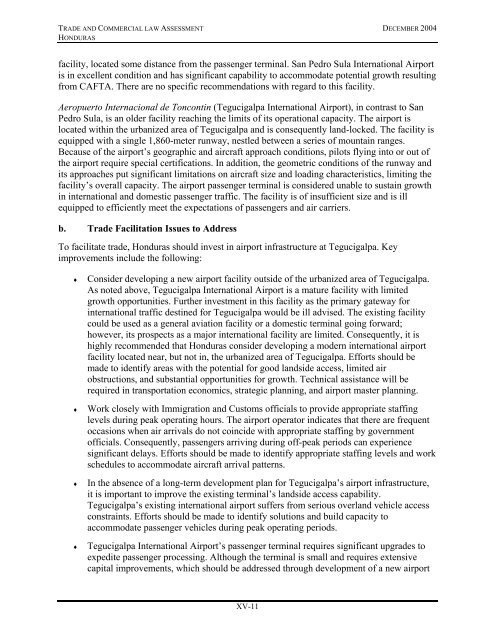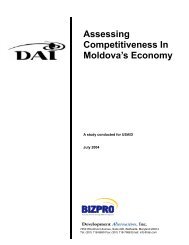Trade and Commercial Law Assessment - Honduras - Economic ...
Trade and Commercial Law Assessment - Honduras - Economic ...
Trade and Commercial Law Assessment - Honduras - Economic ...
You also want an ePaper? Increase the reach of your titles
YUMPU automatically turns print PDFs into web optimized ePapers that Google loves.
TRADE AND COMMERCIAL LAW ASSESSMENT DECEMBER 2004<br />
HONDURAS<br />
facility, located some distance from the passenger terminal. San Pedro Sula International Airport<br />
is in excellent condition <strong>and</strong> has significant capability to accommodate potential growth resulting<br />
from CAFTA. There are no specific recommendations with regard<br />
to this facility.<br />
Aeropuerto Internacional de Toncontin (Tegucigalpa<br />
International Airport), in contrast to San<br />
Pedro Sula, is an older facility reaching the limits of its operational capacity. The airport is<br />
located within the urbanized area of Tegucigalpa <strong>and</strong> is consequently l<strong>and</strong>-locked. The facility is<br />
equipped with a single 1,860-meter runway, nestled between a series of mountain ranges.<br />
Bec ause of the airport’s geographic <strong>and</strong> aircraft approach conditions, pilots flying into or out of<br />
the airport<br />
require special certifications. In addition, the geometric conditions of the runway <strong>and</strong><br />
its approaches put significant limitations on aircraft size <strong>and</strong> loading characteristics, limiting the<br />
facility’s overall capacity. The airport passenger terminal is considered unable to sustain growth<br />
in international<br />
<strong>and</strong> domestic passenger traffic. The facility is of insufficient size <strong>and</strong> is ill<br />
equipped<br />
to efficiently meet the expectations of passengers <strong>and</strong> air carriers.<br />
b.<br />
<strong>Trade</strong> Facilitation Issues to Address<br />
To facilitate<br />
trade, <strong>Honduras</strong> should invest in airport infrastructure at Tegucigalpa. Key<br />
improvements<br />
include the following:<br />
♦ Consider developing a new airport facility outside of the urbanized area<br />
of Tegucigalpa.<br />
As noted above, Tegucigalpa International Airport is a mature facility with limited<br />
growth opportunities. Further investment in this facility as the primary gateway for<br />
international traffic destined for Tegucigalpa would be ill advised. The existing facility<br />
could be used as a general aviation facility or a domestic terminal going forward;<br />
however, its prospects as a major international<br />
facility are limited. Consequently, it is<br />
highly recommended that <strong>Honduras</strong> consider developing a modern international airport<br />
facility located<br />
near, but not in, the urbanized area of Tegucigalpa. Efforts should be<br />
made to identify areas with the potential for good l<strong>and</strong>side access, limited air<br />
obstructions, <strong>and</strong> substantial opportunities for growth. Technical assistance will be<br />
required in transportation economics, strategic planning, <strong>and</strong> airport master planning.<br />
♦ Work closely with Immigration <strong>and</strong> Customs officials to provide appropriate staffing<br />
levels during peak operating hours. The airport operator indicates that there are frequent<br />
occasions when air arrivals do not coincide with appropriate staffing by government<br />
officials. Consequently, passengers arriving during off-peak periods can experience<br />
significant delays. Efforts should be made to identify appropriate staffing levels <strong>and</strong> work<br />
schedules to accommodate<br />
aircraft arrival patterns.<br />
♦ In the absence of a long-term development plan for Tegucigalpa’s airport infrastructure,<br />
it is important to improve the existing terminal’s l<strong>and</strong>side access capability.<br />
Tegucigalpa’s existing international airport suffers from serious overl<strong>and</strong> vehicle access<br />
constraints. Efforts should be made to identify solutions <strong>and</strong> build capacity to<br />
accommodate passenger vehicles during peak operating periods.<br />
♦ Tegucigalpa International Airport’s passenger terminal requires significant upgrades to<br />
expedite passenger processing. Although the terminal is small <strong>and</strong> requires extensive<br />
capital improvements, which should be addressed through development of a new airport<br />
XV-11

















